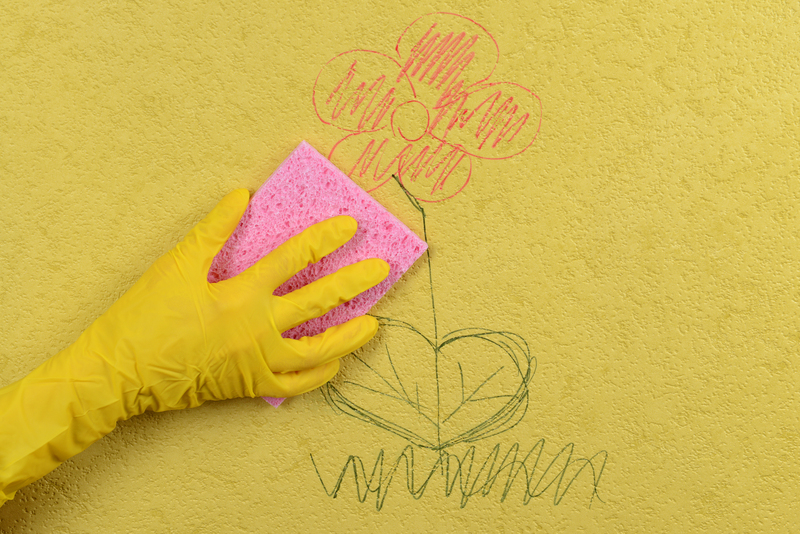Removing Mould from Window Sills: Handy Tips and Tricks
Posted on 14/06/2025
Removing Mould from Window Sills: Handy Tips and Tricks
Dealing with mould on your window sills? Whether you're contending with a little mildew in the corner or a persistent patch that won't go away, removing mould from window sills is essential both for your home's appearance and your family's health. Mold and mildew buildup can cause unsightly stains, unpleasant odours, and even trigger allergies or respiratory problems. In this comprehensive guide, you'll discover the best methods, practical tips, and handy tricks for eliminating mould from window sills and keeping it at bay for good.
Understanding Mould on Window Sills
What Causes Mould on Window Sills?
Mould thrives in damp, dark environments. Unfortunately, window sills--especially in older homes or properties without adequate insulation--can provide the perfect breeding ground. Common causes include:
- Condensation: Water vapor from the air condenses on cold glass and seeps onto the sills.
- Poor Ventilation: Little or no air circulation increases humidity, feeding mould growth.
- Leaky Windows: Faulty seals or frames allow rainwater to seep in and keep the area moist.
- Neglected Cleaning: Dust and dirt provide nutrients for mould spores to grow.
Why Removing Mould from Your Window Sills Is Important
Mold and mildew on window sills are unsightly, but the danger runs deeper. Prolonged exposure can result in:
- Allergies and Respiratory Issues
- Structural Damage: Mould can degrade wood, paint, and sealant on your window sills.
- Persistent Odour: Mildew releases musty smells that permeate your living space.
- Spread to Other Areas: Winodw sill mould can quickly colonise walls and ceilings if left unchecked.

Identifying the Type of Mould on Window Sills
Types of Mould Commonly Found on Window Sills
The most common types of window sill mould include:
- Cladosporium: Usually black or green; most common on painted or wooden surfaces.
- Aspergillus: Often appears as green, yellow, or grey fuzzy patches.
- Penicillium: Blue-green and often powdery in texture.
Identifying the type isn't always necessary for cleaning, but it helps if you have stubborn mould that keeps coming back.
Preparing to Remove Mould from Your Window Sills
Safety First: Protect Yourself
Always use appropriate safety gear when tackling mould removal, especially on window sills where spores can become airborne.
- Gloves: Use rubber or latex gloves to protect your skin.
- Mask: Wear a dust mask or N95 respirator.
- Safety Glasses: Prevent spores or cleaning agents from getting in your eyes.
- Ventilation: Open windows and doors to ensure good airflow.
Gather Essential Cleaning Supplies
Have the following tools and cleaning agents ready for removing mould from window sills:
- Soft brush or old toothbrush
- Microfiber cloths or disposable rags
- Spray bottle
- Household bleach or white vinegar
- Baking soda (optional)
- Protective gear (as listed above)
Best Methods for Removing Mould from Window Sills
1. The Classic Vinegar Solution
White vinegar is a natural, non-toxic remedy that kills up to 82% of mould species. To apply:
- Pour undiluted vinegar into a spray bottle.
- Spray onto the affected window sill areas.
- Let it sit for at least 1 hour to penetrate and kill the mould.
- Scrub gently with a soft brush.
- Wipe down with a damp cloth.
2. Bleach for Stubborn Mould
For tough or deeply embedded mould, bleach is extremely effective:
- Mix 1 part bleach with 3 parts water in a spray bottle.
- Apply liberally to the mouldy area.
- Let it sit for 10-15 minutes.
- Scrub the mould away with a brush.
- Wipe clean with a damp cloth and let dry.
3. Baking Soda for Gentle Mould Removal
If you prefer a gentle, chemical-free solution for removing mould from window sills:
- Mix 1/2 tablespoon of baking soda with 2 cups of water in a spray bottle.
- Shake well and spray onto the mould.
- Scrub with a soft brush.
- Rinse with water and dry with a clean cloth.
4. Commercial Mould Cleaners
You can buy specialised mould-killing sprays for windows and sills. Always follow the manufacturer's safety instructions and test in an inconspicuous area first to ensure compatibility with your sill material.
Preventing Mould from Returning on Window Sills
Essential Maintenance Tips
Prevent the hassle of removing mould from window sills in the future by following these maintenance strategies:
- Wipe Down Regularly: Clean sills every week with a mild detergent or vinegar spray.
- Improve Ventilation: Open windows frequently to boost airflow.
- Use a Dehumidifier: Reduce indoor moisture, especially in kitchens and bathrooms.
- Repair Leaks Promptly: Ensure that window flashing, seals, and frames are watertight.
- Remove Condensation: Wipe away moisture from windows daily, especially in winter.
Applying Anti-Mould Paints and Treatments
If your window sills are prone to mould, consider repainting them with anti-mould paint. You can also apply special mould-resistant sealants to wooden sills, reducing the risk of future outbreaks.
Deep Cleaning Wooden and UPVC Window Sills
How to Remove Mould from Wooden Window Sills
- Avoid saturating the wood--use a lightly-dampened cloth.
- If paint is peeling, sand lightly and repaint with mould-resistant paint.
- For stubborn stains, use a wood cleaner designed for mould and mildew.
How to Remove Mould from UPVC Window Sills
- UPVC is non-porous and easier to clean but use non-abrasive cleaners to prevent scratching.
- A mild bleach or vinegar solution works effectively.
- Wipe thoroughly to prevent streaking or residue buildup.

Frequently Asked Questions about Removing Mould from Window Sills
- Is mould on window sills dangerous?
Yes. Prolonged exposure, especially to black mould, can trigger allergies and respiratory problems. - Can I paint over mouldy window sills?
No--always remove all traces of mould before repainting to prevent recurrence. - What's the best solution for people with allergies?
Use natural remedies like vinegar or baking soda first, and always ventilate the area well. - How often should I check my window sills for mould?
Check every couple of weeks, especially in damp months. - When should I call a professional?
If the mould covers an area larger than one square metre or recurs despite treatment, consider professional removal.
Conclusion: Enjoy Clean, Healthy Window Sills
Removing mould from window sills doesn't have to be daunting. By using the right cleaning agents, applying preventive measures, and staying vigilant, you can keep your home mould-free and enjoy sparkling, healthy windows all year round. Take action today, and you'll enjoy cleaner air, better-looking interiors, and the peace of mind that comes from a job well done.
For more handy home improvement and cleaning tips, be sure to explore our other guides on keeping your living spaces safe and beautiful!


